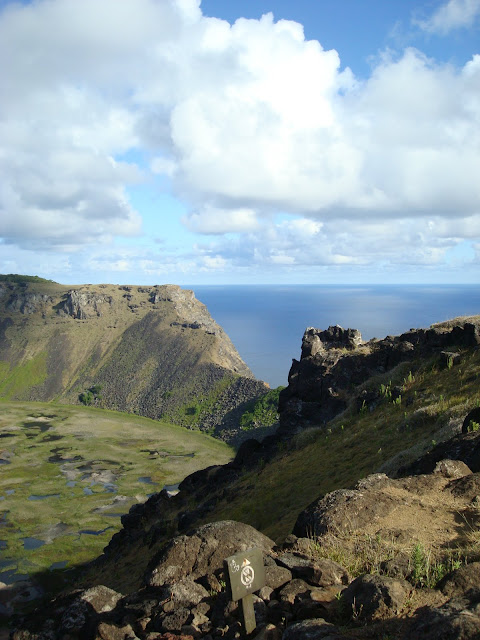We had trouble wrapping our heads around the fact that we were going to Easter Island and that we would be there over Christmas. I didn't pack until the day we left -- what was up with that!?
We arrived on Easter Island (a.k.a., Isla de Pascua or Rapa Nui) mid-afternoon on the 22nd of December. We got settled in our hotel
and then headed out on our first excursion. I'll not bore you with the names of all the moais and will instead just bore you with all the pictures I took!!
Our guide, Rodrigo (a.k.a., YoYo) began our Easter Island experience with trips to moais that had not been reconstructed. But what are moais you ask? Okay, that was what I asked. Anyway, a theory is that moais we created by "clans" to represent an important member of a family group (and evidently, there were a lot of family groups on the island.) And, the possible reason they were pushed over was that there were perhaps "rifts" between the families, which may have come about due to overpopulation of the island and the resulting lack of natural resources, and competing clans "vandalized" other clans moais? Some of the ahus (platforms the moais rested on) were actually completed covered with rocks -- almost as though they were buried. Interesting too was that YoYo explained that bones from the family member were discovered underneath a corresponding moai. And get this, the clean, efficient means of acquiring the bones of the individual was to put them in the ocean and wait for the ultimately resulting bones --- hmmmm.
Below is a picture of the city of Hanga Roa.
This is a view of the Rano Kau crater -- the largest volano (all of which are inactive by the way) on the island.
Our tour jumps ahead in time by going to this site because it respresents an area used by the Rapa Nui after construction of the moais ceased and instead, the Rapa Nui people began a type of iron-man competition between "clans" where the "chosen" one from the clans would dive into the water (I do believe this was done from the gap in the crater above) and swim out to an island (see below photo of islands), grab a bird egg, swim back and hike up the sea side of the crater -- the winner of the competition would became a leader of sorts and was able to claim a fertile virgin and therefore continue with leadership on the island only coming from the strongest of the strong of the Rapa Nui -- the fellows who competed were called "bird men".
And below is the reconstructed "ceremonial" village of Orongo where, it is speculated, family members of the "bird men" hung out while the fellows trained for the competition.
Sunset, a nice bottle of vino and dinner on the hotel porch with a view of the Pacific -- priceless!
Christmas Eve Day, YoYo introduced us to reconstructed moai, the largest grouping of moais (The 15) where we'd also see the largest moai and below was the coastal view on our way.
This fellow marks the entrance to the aformentioned moai grouping and in the background is the quarry where the moai were "harvested."
The lava rock hat on the second fellow from the end was actually a representation of hair pulled up on top of the representative Rapa Nui's head.
Picnic on a white sand beach -- with hardly any people....
and more moai....
Christmas Day was a full-day excursion hiking along the path that the moai traveled to their multiple ahu (platform) locations. There are many, many moai found along this path and it is speculated that they were in transit to their locations when, for whatever reason, the practice of constructing ahus with moai stopped and these moai were merely left exactly where they were when in the process of being moved to their ultimate destination? Our destination on this days hike was the quarry where all of the moai came from.
See that rain in the background -- it finds us! We loved it -- haven't seen (smelled, felt) rain since early August when we were in Colorado -- loved it!
So, after this short side hike (above) up a small peak, we resumed our hike to the quarry located in the crater of another volcano.
Below is an example of what condition the moai were found (nearly buried due to erosion), and as a result of excavation, an example of the detail on the moai that has been preserved due to having been covered with dirt and not subject to erosion.
In the below picture, look a the base of the rock above the center hilly area and you'll see a moai as it was being carved and harvested from the hill -- not a clue as to how they really moved them but our guide was telling us that Kevin Costner produced a movie on the island called Rapa Nui that is evidently an attempt at interpreting how movement of the moai took place --
And as we waited for our plane to leave Easter Island and this very unique Christmas experience, I include a photo of this very good beer brewed on Easter Island.
So, as I finish this post, I end with a picture of the glimpse I got of the lunar eclipse in Calama around 6 a.m. on December 21 --
Next post will be a very short one from our New Year's Eve celebration ... Feliz 2011!





































